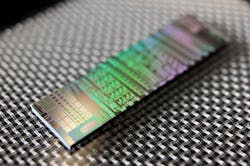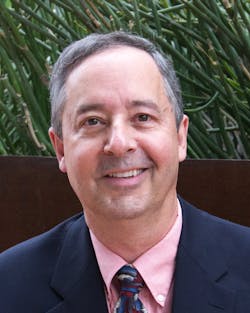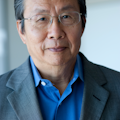Part 2: Making things in academia: From telescope optics to nanophotonics
This month is the second part of an interview with Professor Tom Koch, who is Dean of the College of Optical Sciences at the University of Arizona (UA). (The acronym OSC is used as a reminder of its roots, the Optical Sciences Center.) Tom studied under the tutelage of Professor Amnon Yariv at Caltech after earning an A.B. from Princeton. He started his working career at Bell Labs, and rose to the position of Vice President of Technology Platforms at Lucent/Agere before moving into academia. The mission of the OSC is to conduct research and provide the state of Arizona and the nation with trained engineers and physicists in optical sciences.
Milton Chang: How do you deal with diminishing state funding?
Tom Koch: Every public university is struggling with funding, but our college has historically been funded to a large degree by research. We often have large-value projects, but we also have funding from a variety of sources to provide some degree of stability. Another big piece of the solution is getting closer to industry.This is another hallmark of our college—since the very beginning, we have emphasized working with industry. Publications and conferences are essential, but when your work is part of a complete solution showcased in a full-blown system implementation, people are more likely to engage because they can see the efficacy of your technical approach.
MC: What percentage of your funding comes from industry?
TK: Our annual research expenditures have averaged $20–30 million for quite a few years. The fraction from industry is as much as 40%. That ratio is unusually high, I think, in part because a lot of our faculty used to be in industry and know the priorities of our corporate partners. There is mutual trust and respect because many of our faculty understand the challenges of developing real products.
Some of our industry linkages are based on single projects—for example, some of the larger ones are subcontracts from a company working on a big federal program. In other cases, we have had corporate relationships that support a collection of multi-year projects under an umbrella agreement.
MC: Does industrial partnership result in a greater number of startups around the university?
TK: The work at OSC has led to quite a few successful startups. Many are small with a handful of employees, but quite a few are larger. Jim Wyant is a great example. The University let him maintain his position here while he was starting WYKO, and then he repeated with 4D Technology. There are many design and consulting companies. Nasser Peyghambarian has started several companies, including NP Photonics and TIPD. In the big optics area, there is a company that was spun out of our optics shop recently called Arizona Optical Systems, and they are doing quite well.
MC: What are your priorities going forward?
TK: I am certainly aiming to continue our strong support of the fundamental optical physics at OSC. This work can have high impact in unpredictable ways, attract brilliant faculty, and also get a lot of visibility for the college. And I want to double-down on our collaboration with industry for faculty who are more engineering-focused. I like to get people thinking about how their research will actually impact the world.
I want to provide the infrastructure needed to realize the system-level technology so individuals can really show the efficacy of their ideas. For example, in our joint optics shop with Astronomy here at UA, we have 150 professional staff working on projects, and they are not limited to grinding glass; there is mechanical, software engineering, etc. These are people used to doing real deployable things. So, why don't we shop the capability around?
MC: Hard to imagine academics would align with your priorities.
TK: I think some of our faculty who are focused on fundamental work may feel uncomfortable when I talk a lot about expanding our ability to do more systems-level work. That's not for everyone, and I hope they will see that any success in this area does not come at their expense. I think many of our faculty are interested in the extraordinary research opportunities they see when they get closer to real, cutting-edge problems. We would love to be your partner if you want to do unique system development R&D programs—not just a product variant, but really challenging specialized projects that involve optics. I would like to be the go-to partner nationally and maybe even internationally.
MC: I suspect you have to leverage government contracts for infrastructure building. State universities do not have the endowments that Princeton and Stanford, or even Caltech, have.
TK: As a public institution, we only have four sources of funding: state support, tuition, research funding, and philanthropy. Our college has always been very focused on research. Our performance has protected us to some degree, but we need to expand the program with increased research funding from both federal agencies and industry. Income from tuition has risen when the legislature reduces state support, but there are obviously limits.
It is hard to support an enterprise on philanthropy. However, we have been really fortunate to get a very large endowment for scholarships specifically for our college. Jim Wyant spearheaded that with a 4-1 matching campaign that enables donors to create endowed scholarships in a name of their choosing, with Jim's 80% contribution completely in the background. It is pretty exceptional! This has been really exciting and was the capstone of OSC's 50-year anniversary. We will be at a point where every entering Ph.D. student has their first year covered so they can focus entirely on studies, learning about research opportunities, and deciding what they want to do.
MC: Give us a few vital statistics about your college.
TK: I believe that we are the largest optics education and research enterprise in the U.S. measured by research volume or by the number of graduates each year. We have granted over 2500 degrees cumulatively, which is similar to the University of Rochester's figure, but our slope is higher at this point. Each year, we graduate 25-30 Ph.D., 40 M.S., and 30 B.S. students.
We have about 60 faculty, which are split nearly equally between our tenure/tenure-track or teaching faculty and our research faculty, and we also have 40 joint appointments across the UA campus. Our research accomplishments are outstanding, but I think our biggest impact is our students—a lot of the talent in optics and photonics in the U.S. comes from our college.
MC: What is your vision of OSC when you retire?
TK: I hope that OSC will be more widely known as the most exciting place for students to study optics and photonics. I also want it to be known as an outstanding place for researchers to realize breakthroughs in both fundamental optical physics and engineering technology. I hope that we have also developed a reputation for being a superb collaborative partner in creating and developing the most important and innovative applications of optics in the world.
MC: How about ending the discussion with a few words of wisdom.
TK: The impact of optics on technology and our lives will expand even beyond where it is today, and there will be really exciting opportunities at the boundaries between fields. My advice to graduating students may sound like a cliché: You should never let yourself lose the sense of excitement about what you are working on. Don't be afraid to try new things.
You worked really hard to get to where you are and that's your ticket to an exciting career. Never give up working on something really challenging because your excitement and energy are truly the biggest edge you've got!
About the Author
Milton Chang
MILTON CHANG of Incubic Management was president of Newport and New Focus. He is currently director of mBio Diagnostics and Aurrion; a trustee of Caltech; a member of the SEC Advisory Committee on Small and Emerging Companies; and serves on advisory boards and mentors entrepreneurs. Chang is a Fellow of IEEE, OSA, and LIA. Direct your business, management, and career questions to him at [email protected], and check out his book Toward Entrepreneurship at www.miltonchang.com.


